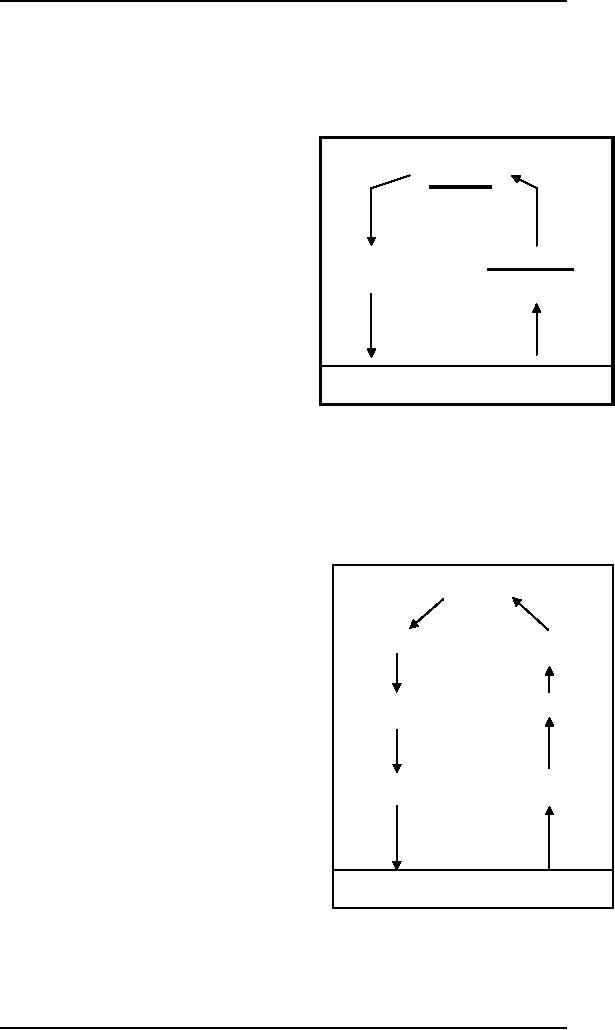 |
THE PSYCHOLOGY OF ACTIONS: MENTAL MODEL, ERRORS |
| << COGNITIVE PROCESSES: LEARNING, READING, SPEAKING, LISTENING, PROBLEM SOLVING, PLANNING, REASONING, DECISION-MAKING |
| DESIGN PRINCIPLES: >> |

Human
Computer Interaction
(CS408)
VU
Lecture
11
Lecture
11. The
Psychology of Actions
Learning
Goals
As the
aim of this lecture is to
introduce you the study of
Human Computer
Interaction,
so that after studying this
you will be able to:
Understand
mental models
�
Understand
psychology of actions
�
Discuss
errors.
�
Mental
model
11.1
The
concept of mental model has
manifested itself in psychology
theorizing and HCI
research
in a multitude of ways. It is difficult
to provide a definitive
description,
because
different assumption and
constraints are brought to
bear on the different
phenomena
it has been used to explain.
A well-known definition, in the
context of
HCI, is
provided by Donald Norman:
`the model people have of
themselves, others,
the
environment, and the things
with which they interact.
People form mental
models
through
experience, training and
instruction'.
It should
be noted that in fact the
term mental model was
first developed in the
early
1640s by
Kenneth Craik. He proposed
that thinking `...models, or
parallels reality':
`If the
organism carries a "small-scale model" of
external reality and of its
own
possible
actions within its head, it is
able to try out various
alternatives, conclude
which is
the best of them, react to
future situations before
they arise, utilize
the
knowledge
of past events in dealing with
the present and future, and
in every way to
react in a
much fuller, safer, and more
competent manner to emergencies witch
face
it.'
Just as
an engineer will build scale
models of a bridge, in order to
test out certain
stresses
prior to building the real
thing, so, too, do we build
mental models of the
world in
order to make predictions
about an external event
before carrying out
an
action?
Although our construction
and use of mental models
may not be as
extensive
or as
complete as Craik's hypothesis
suggests, it is likely that most of us
can probably
recall
using a form of mental
simulation at some time or
other. An important
observation
of these types of mental
models is that they are
invariably incomplete,
unstable,
and easily confusable and
are often based on
superstition rather
than
scientific
fact.
Within
cognitive psychology the
term mental model has
since been explicated by
Johnson-Laird
(1983, 1988) with respect to
its structure and function
in human
reasoning
and language understanding. In terms of
structure of mental models,
he
argues
that mental models are
either analogical representations or a
combination of
analogical
and prepositional representations.
They are distinct from,
but related to
images. A
mental model represents the
relative position of a set of
objects in an
94

Human
Computer Interaction
(CS408)
VU
analogical
manner that parallels the
structure of the state of
objects in the world.
An
image
also does this, but more
specifically in terms of view of a
particular model.
An
important difference between images
and mental models is in
terms of their
function.
Mental models are usually
constructed when we are
required to make an
inference
or a prediction about a particular
state of affairs. In constructing
the mental
model a
conscious mental simulation may be
`run' from which conclusions
about the
predicted
state of affairs can be
deduced. An image, on the
other hand, is
considered
to be a
one-off representation. A simplified
analogy is to consider an image to be
like
a frame
in a movie while a mental
model is more like a short
snippet of a movie.
So, after
this discussion we can say
that while learning and
using a system, people
develop
knowledge of how to use the
system and, to a lesser
extent, how the
system
works.
These two kinds of knowledge
are often referred to as a user's
mental model.
Having
developed a mental model of an
interactive product, it is assumed
that people
will use
it to make inferences about
how to carry out tasks
when using the
interactive
product.
Mental models are also
used to fathom what to do
when something
unexpected
happens with a system and
when encountering unfamiliar
systems. The
more
someone learns about a
system and how it functions,
the more their
mental
model
develops. For example, TV
engineers have a deep mental
model of how TVs
work
that allows them to work
out how to fix them. In
contrast, an average citizen
is
likely to
have a reasonably good
mental model of how to
operate a TV but a
shallow
mental
model of how it
worked.
To
illustrate how we use mental
models in our everyday
reasoning, imagine
the
following
scenario:
� You
arrive home from a holiday
on a cold winter's night to a
cold house. You
have
small baby and you need to
get the house warm as
quickly as possible.
Your
house is centrally heated. Do
you set the thermostat as
high as possible
or turn
it to the desired temperature
(e.g., 70F)
Most
people when asked the
questions imagine the scenario in terms
of what they
would do
in their own house they
choose the first option.
When asked why, a
typical
explanation
that is given is that
setting the temperature to be as
high as possible
increases
the rate at which the
room warms up. While many
people may believe
this,
it is
incorrect.
There
are two commonly held
folk theories about thermostats:
the timer theory
and
the
valve theory. The timer
theory proposes that the
thermostat simply controls
the
relative
proportion of time that the
device stays on. Set the
thermostat midway,
and
the
device is on about half the
time; set it all the
way up and the device is on
all the
time;
hence, to heat or cool something most
quickly, set the thermostat
so that the
device is
on all the time. The
valve theory proposes that
the thermostat controls
how
much heat
comes out of the device.
Turn the thermostat all
the way up, and
you get
maximum
heating or cooling.
Thermostats
work by switching on the heat
and keeping it going at a constant
speed
until
the desired temperature set
is reached, at which point they
cut out. They
cannot
control
the rate at which heat is
given out from a heating
system. Left a given
setting,
thermostats
will turn the heat on an off
as necessary to maintain the
desired
temperature.
It treats the heater, oven,
and air conditioner as
all-or-nothing devices
that
can be either fully on or
fully off, with no
in-between states. The
thermostat turns
the
heater, oven, or air
conditioner completely on--at
full power--until the
temperature
setting on the thermostat is reached.
Then it turns the unit
completely off.
95

Human
Computer Interaction
(CS408)
VU
Setting
the thermostat at one
extreme cannot affect how
long it takes to reach the
desired
temperature.
The
real point of the example is
not that some people
have erroneous theories; it
is
that
everyone forms theories
(mental models) to explain
what they have observed.
In
the
case of the thermostat the
design gives absolutely no
hint as to the correct
answer.
In the
absence of external information,
people are free to let
their imaginations
run
free as
long as the mental models
they develop account for the
facts as they perceive
them.
Why do
people use erroneous mental
models?
It seems
that in the above scenario,
they are running a mental
model based on
general
valve
theory of the way something
works. This assumes the
underlying principle of
"more is
more": the more you
turn or push something, the
more it causes the
desired
effect.
This principle holds for a
range of physical devices,
such as taps and
radio
controls,
where the more you
turn them, the more
water or volume is given.
However,
it does
not hold for thermostats,
which instead function based
on the principle of an
on-off
switch. What seems to happen
is that in everyday life
people develop a core
set
of
abstractions about how
things work, and apply
these to a range of
devices,
irrespective
of whether they are
appropriate.
Using
incorrect mental models to
guide behavior is surprisingly
common. Just watch
people at
a pedestrian crossing or waiting for an
elevator (lift). How many
times do
they
press the button? A lot of
people will press it at least twice.
When asked why, a
common
reason given is that they
think it will make it lights change
faster or ensure
the
elevator arrives. This seems
to do another example of following
the "more is
more"
philosophy: it is believed that
the more times you
press the button, the
more
likely it
is to result in he desire
effect.
Another
common example of an erroneous
mental model is what people
do when the
cursor
freeze on their computer screen.
Most people will bash away
at all manner of
keys in
the vain hope that
this will make it work
again. However, ask them
how this
will help
and their explanations are
rather vague. The same is
true when the TV
starts
acting
up: a typical response is to
hit the top of the
box repeatedly with a bare
hand or
a
rolled-up newspaper. Again, as people
why and their reasoning
about how this
behavior
will help solve the problem
is rather lacking.
Indeed,
research has shown that
people's mental models of
the way interactive
devices
work is poor, often being
incomplete, easily confusable,
based on
inappropriate
analogies, and superstition.
Not having appropriate
mental models
available
to guide their behavior is
what caused people to become
very frustrate--
often
resulting is stereotypical "venting'
behavior like those
described above.
On the
other hand, if people could
develop better mental models
of interactive
systems,
they would be in a better
position to know how to
carry out their
tasks
efficiently
and what to do if the system
started acting up. Ideally,
they should be able
to
develop a mental model that
matches the conceptual;
modal developed by
the
designer.
But how can you
help users to accomplish
this? One suggestion is to
educate
them better, however, many
people are resistant to spending
much time
learning
about how things work,
especially if it involves reading manuals
and other
documentation.
An alternative proposal is to design
systems to be more
transparent,
so that
they are easier to
understand.
People do
tend to find causes for
events, and just what
they assign as the cause
varies.
In part
people tend to assign a causal
relation whenever two things
occur in
96

Human
Computer Interaction
(CS408)
VU
succession.
If I do some action A just
prior to some result R, then
I conclude that A
must have
caused R, even if, there
really was no relationship
between the two.
Self-blaming
Suppose I
try to use an everyday
thing, but I can't: where is
the fault, in my action
or
in the
thing? We are apt to blame
ourselves. If we believe that others
are able to use
the
device and if we believe
that it is not very complex,
then we conclude that
any
difficulties
must be our own fault.
Suppose the fault really
lies in the device, so
that
lots of
people have the same
problems. Because everyone
perceives the fault to be
his
or own,
nobody wants to admit to
having trouble. This creates
a conspiracy of silence,
maintaining
the feeling of guilt and
helplessness among
users.
Interestingly
enough, the common tendency
to blame ourselves for
failures with
everyday
objects goes against the
normal attributions people
make. In general, it
has
been
found that normal attribute
their own problems to the
environment, those of
other
people to their
personalities.
It seems
natural for people to blame
their own misfortunes on the
environment. It
seems
equally natural to blame
other people's misfortunes on
their personalities.
Just
the
opposite attribution, by the
way, is made when things go
well. When things go
right,
people credit their own
forceful personalities and
intelligence. The onlookers
do
the
reverse. When they see
things go well for someone
else, they credit the
environment.
In all
cases, whether a person is
inappropriately accepting blame
for the inability to
work
simple objects or attributing
behavior to environment or personality, a
faulty
mental
model is at work.
Reason
for self-blaming
Learned
helplessness
The
phenomenon called learned
helplessness might help
explain the self-blame.
It
refers to
the situation in which
people experience failure at a
task, often numerous
times. As
a result, they decide that
the task cannot be done, at
least not by them:
they
are
helpless. They stop trying. If
this feeling covers a group of
tasks, the result can
be
severe
difficulties coping with
life. In the extreme case,
such learned
helplessness
leads to depression
and to a belief that the
person cannot cope with everyday
life at
all.
Some times all that it takes
to get such a feeling of
helplessness is a few
experiences
that accidentally turn out
bad. The phenomenon has been
most frequently
studied
as a precursor to the clinical
problem of depression, but it might
easily arise
with a
few bad experiences with
everyday life.
Taught
helplessness
Do the
common technology and mathematics
phobias results from a kind of
learned
helplessness?
Could a few instances of failure in
what appear to be straightforward
situations
generalize to every technological
object, every mathematics
problem?
Perhaps.
In fact, the design of
everyday things seems almost
guaranteed to cause
this.
We could
call this phenomenon taught
helplessness.
With
badly designed objects--constructed so as
to lead to
misunderstanding--faulty
mental
models, and poor feedback,
no wonder people feel guilty
when they have
trouble
using objects, especially
when they perceive that
nobody else is having
the
97

Human
Computer Interaction
(CS408)
VU
same
problems. The problem is
that once failure starts, it soon
generalizes by self-
blame to
all technology. The vicious
cycle starts: if you fail at
something, you think
it
is your
fault. Therefore you think
you can't do that task. As a
result, next time
you
have to
do the task, you believe
you can't so you don't
even try. The result is
that you
can't,
just as you thought. You are
trapped in a self-fulfilling
prophecy.
The
nature of human thought and
explanation
It isn't
always easy to tell just
where the blame for
problem should be placed.
A
number of
dramatic accidents have come
about, in part, from the
false assessment of
blame in
a situation. Highly skilled,
well-trained people are
using complex
equipment
when
suddenly something goes
wrong. They have to figure
out what the problem
is.
Most
industrial equipment is pretty
reliable. When the
instruments indicate
that
something
is wrong, one has to
consider the possibility
that the instruments
themselves are
wrong. Often this is the
correct assessment. When
operators
mistakenly
blame the instruments for an
actual equipment failure,
the situation is ripe
for a
major accident.
It is
spectacularly easy to find
examples of false assessment in
industrial accidents.
Analysts
come in well after the
fact, knowing what actually
did happen; with
hindsight,
it is almost impossible to understand
how the people involved
could have
made the
mistake. But from the
point of view of the person
making decisions at
time,
the
sequence of events is quite
natural.
Three
Mile Island Nuclear Power
Plant
At the
Three Mile Island nuclear
power plant, operators pushed a
button to close a
valve;
the valve had been opened
(properly) to allow excess
water to escape from
the
nuclear
core. In fact, the valve
was deficient, so it didn't close.
But a light on the
control
panel indicated that the
valve position was closed.
The light actually
didn't
monitor
the valve, only the
electrical signal to the
valve, a fact known by
the
operators.
Still, why suspect a
problem? The operators did
look at the temperature
in
the
pipe leading from the
valve: it was high,
indicating that fluid was
still flowing
through
the closed valve. Ah,
but the operators knew
that the valve had been
leaky, so
the
leak would explain the
high temperature; but the
leak was known to be small,
and
operators
assumed that it wouldn't
affect the main operation.
They were wrong,
and
the
water that was able to
escape from the core added
significantly to the problems
of
that
nuclear disaster. Norman says
that the operators'
assessment was
perfectly
reasonable:
the fault wan is the
design of the lights and in
the equipment that
gave
false
evidence of a closed valve.
Lockheed
L-1011
Similarly
many airline accidents happened
just due to misinterpretations.
Consider
flight
crew of the Lockheed L-1011
flying from Miami, Florida,
to Nassau, Bahamas.
The
plane was over the
Atlantic Ocean, about 110
miles from Miami, when
the low
oil
pressure light for one of
the three engines went
on. The crew turned
off the engine
and
turned around to go back to
Miami. Eight minutes later,
the low-pressure
lights
for
the remaining two engines
also went on, and
the instruments showed zero
oil
pressure
and quantity in all three
engines. What did the
crew do now? They
didn't
believe
it! After all, the
pilot correctly said later,
the likelihood of simultaneous
oil
exhaustion
in all three engines was
"one in millions I would
think." At the time,
sitting
in the airplane, simultaneous
failure did seem most
unlikely. Even the
National
98

Human
Computer Interaction
(CS408)
VU
Transportation
Safety Board declared, "The
analysis of the situation by
the flight crew
was
logical, and was what most
pilots probably would have
done if confronted by
the
same
situation."
What
happened? The second and
third engines were indeed
out of oil, and they
failed.
So there
were no operating engines:
one had been turned off
when its gauge
registered
low,
the other two had
failed. The pilots prepared
the plane for an emergency
landing
on the
water. The pilots were
too busy to instruct the
flight crew properly, so
the
passengers
were not prepared. There
was semi-hysteria in the
passenger cabin. At
the
last
minute, just as the plane
was about to ditch in the
ocean, the pilots managed to
restart
the first engine and
land safely to Miami. Then
that engine failed at the
end of
the
runway.
Why
did all three engine
fail? Three missing O-rings,
one missing from each of
three
oil
plugs, allowed all the
oil to seep out. The
O-rings were put in by two
different
people
who worked on the three
engines (one for the
two plugs on the wings,
the
other of
the plug on the tail).
How did both workers
make the same mistake?
Because
the
normal method by which they
got the oil plugs
had been changed that day.
The
whole
tale is very instructive,
for there were four
major failures of different
sorts,
from
the omission of the O-rings,
to the inadequacy of the
maintenance procedures, to
the
false assessment of the
problem, to the poor
handling of the
passengers.
Fortunately
nobody was injured. The
analysts of the National Transportation
Safety
Board
got to write a fascinating
report.
Find an
explanation, and we are
happy. But our explanations
are based on analogy
with
past experience, experience
that may not apply in
the current situation. In
the
Three
Mile Island incident, past
experience with the leaky
valve explained away
the
discrepant
temperature reading; on the
flight from Miami to Nassau,
the pilots' lack of
experience
with simultaneous oil
pressure failure triggered
their belief that
the
instruments
must be faulty. Once we have an
explanation--correct or
incorrect--for
otherwise
discrepant or puzzling events,
there is no more puzzle, no
more
discrepancy.
As a result, we are complacent, at least
for a while.
How
people do things
To get
something done, you have to
start with some notion of
what is wanted--the
goal
that is to be achieved. Then,
you have to do some thing to
the world , that is,
take
action to
move yourself or manipulate
someone or something. Finally,
you check to
see
that your goal was made. So
there are four different
things to consider: the
goal,
what is
done to the world, the
world itself, and the
check of the world. The
action
itself
has two major aspects:
doing something and
checking. Call these
execution and
evaluation
Goals do not state precisely
what to do--where and how to
move, what to
pick
up. To lead to actions goals
must be transformed into specific
statements of what
is to be
done, statements that are
called intentions. A goal is
some thing to be
achieved,
often vaguely stated. An intention is
specific action taken to get
to the goal.
Yet
even intentions are not
specific enough to control
actions.
Suppose I
am sitting in my armchair, reading a
book. It is dust, and the
light has
gotten
dimmer and dimmer. I decide
to need more light (that is
the goal: get
more
light).
My goal has to be translated
into the intention that
states the appropriate
action
in the
world: push the switch
button on the lamp. There's
more: I need to specify
how
to move
my body, how to stretch to reach the
light switch, how to extend
my finger to
push the
button (without knocking
over the lamp). The
goal has to be translated
into
an
intention, which in turn has
to make into a specific
action sequence, one that
can
99

Human
Computer Interaction
(CS408)
VU
control
my muscles. Note that I
could satisfy my goal with
other action
sequences,
other
intentions. If some one
walked into the room
and passed by the lamp, I
might
alter my
intention form pushing the
switch button to asking the
other person to do it
for me.
The goal hasn't changed,
but the intention and
resulting action sequence
have.
Action
Cycle
Human
action has two aspects,
execution
Goals
and
evaluation. Execution involves
doing
What we
want to
something.
Evaluation is the comparison
of
happen
what
happened in the world with
what we
wanted to
happen
Evaluation
Execution
to
Stages of
Execution
What we
do
Comparing
what
the
world
Happened
with what we
Start at
the top with the
goal, the state that
is
wanted to
happen
to be
achieved. The goal is
translated into an
intention
to do some action. The
intention
must be
translated into a set of
internal
commands, an
action sequence that can
be
THE
WORLD
performed
to satisfy the intention.
The
action
sequence is still a mental
event:
noting
happens until it is executed, performed
upon the world.
Stages of
Evaluation
Evaluation
starts with our perception
of the world. This
perception must then be
interpreted
according to our expectations
and then compared with
respect to both our
intentions
and our goals
Seven
stages of action
Goals
Intention to
act
Evaluation of
the
Interpretations
The
stages of execution (intentions,
action
sequence,
and execution) are coupled
with
the
stages of evaluation
(perception,
sequence
of
Interpreting
the
interpretation,
and evaluation), with
goals
actions
perception
common to
both stages.
Errors
11.2
execution
of
Perceiving
the state
The
action sequence
of the
world
Human
capability for interpreting
and
manipulating
information
is
quite
impressive.
However, we do make
mistake.
Whenever
we try to learn a new skill,
be it
skiing,
typing, cooking or playing
chess, we
are bound
to make mistakes. Some
are
THE
WORLD
trivial,
resulting in no more than
temporary
inconvenience
or annoyance. Other may be
more serious, requiring substantial
effort
to
correct. In most situations it is not
such a bad thing because
the feedback from
making
errors can help us to learn
and understand an activity.
When learning to use
a
computer
system, however, learners
are often frightened of
making errors because,
as
100

Human
Computer Interaction
(CS408)
VU
well as
making them feel stupid,
they think it can result in
catastrophe. Hence, the
anticipation
of making an error and its
consequences can hinder a
user's interaction
with a
system.
Why do we
make mistakes and can we
avoid them? In order to answer the
latter part
of the
question we must first look at
what is going on when we
make an error. There
are
several different types of
errors. Some errors result
from changes in the context
of
skilled
behavior. If a pattern of behavior
has become automatic and we
change some
aspect of
it, the more familiar
pattern may break through
and cause an error. A
familiar
example of this is where we
intend to stop at the shop on the
way home from
work
but in fact drive past.
Here, the activity of
driving home is the more
familiar and
overrides
the less familiar
intention.
Other
errors result from an incorrect
understanding, or model, of a situation
or system.
People
build their own theories to
understand the casual
behavior of systems.
These
have been
termed mental models. They
have a number of characteristics.
Mental
models
are often partial: the
person does not have a full
understanding of the
working
of the
whole system. They are
unstable and are subject to
change. They can be
internally
inconsistent, since the person may
not have worked through
the logical
consequences
of their beliefs. They are
often unscientific and may
be based on
superstition
rather than evidence. Often
they are based on an incorrect
interpretation
of the
evidence.
A
classification of errors
There
are various types of errors.
Norman has categorized them
into two main
types,
slips
and mistakes:
Mistakes
Mistakes
occur through conscious deliberation. An
incorrect action is taken
based on
an
incorrect decision. For
example, trying to throw the
icon of the hard disk
into the
wastebasket, in
the desktop metaphor, as a
way of removing all existing
files from the
disk is a
mistake. A menu option to
erase the disk is
appropriate action.
Slips
Slips
are unintentional. They
happen by accident, such as
making typos by pressing
the
wrong key or selecting wrong
menu item by overshooting.
The most frequent
errors
are slips, especially in well-learned
behavior.
101
Table of Contents:
- RIDDLES FOR THE INFORMATION AGE, ROLE OF HCI
- DEFINITION OF HCI, REASONS OF NON-BRIGHT ASPECTS, SOFTWARE APARTHEID
- AN INDUSTRY IN DENIAL, SUCCESS CRITERIA IN THE NEW ECONOMY
- GOALS & EVOLUTION OF HUMAN COMPUTER INTERACTION
- DISCIPLINE OF HUMAN COMPUTER INTERACTION
- COGNITIVE FRAMEWORKS: MODES OF COGNITION, HUMAN PROCESSOR MODEL, GOMS
- HUMAN INPUT-OUTPUT CHANNELS, VISUAL PERCEPTION
- COLOR THEORY, STEREOPSIS, READING, HEARING, TOUCH, MOVEMENT
- COGNITIVE PROCESS: ATTENTION, MEMORY, REVISED MEMORY MODEL
- COGNITIVE PROCESSES: LEARNING, READING, SPEAKING, LISTENING, PROBLEM SOLVING, PLANNING, REASONING, DECISION-MAKING
- THE PSYCHOLOGY OF ACTIONS: MENTAL MODEL, ERRORS
- DESIGN PRINCIPLES:
- THE COMPUTER: INPUT DEVICES, TEXT ENTRY DEVICES, POSITIONING, POINTING AND DRAWING
- INTERACTION: THE TERMS OF INTERACTION, DONALD NORMAN’S MODEL
- INTERACTION PARADIGMS: THE WIMP INTERFACES, INTERACTION PARADIGMS
- HCI PROCESS AND MODELS
- HCI PROCESS AND METHODOLOGIES: LIFECYCLE MODELS IN HCI
- GOAL-DIRECTED DESIGN METHODOLOGIES: A PROCESS OVERVIEW, TYPES OF USERS
- USER RESEARCH: TYPES OF QUALITATIVE RESEARCH, ETHNOGRAPHIC INTERVIEWS
- USER-CENTERED APPROACH, ETHNOGRAPHY FRAMEWORK
- USER RESEARCH IN DEPTH
- USER MODELING: PERSONAS, GOALS, CONSTRUCTING PERSONAS
- REQUIREMENTS: NARRATIVE AS A DESIGN TOOL, ENVISIONING SOLUTIONS WITH PERSONA-BASED DESIGN
- FRAMEWORK AND REFINEMENTS: DEFINING THE INTERACTION FRAMEWORK, PROTOTYPING
- DESIGN SYNTHESIS: INTERACTION DESIGN PRINCIPLES, PATTERNS, IMPERATIVES
- BEHAVIOR & FORM: SOFTWARE POSTURE, POSTURES FOR THE DESKTOP
- POSTURES FOR THE WEB, WEB PORTALS, POSTURES FOR OTHER PLATFORMS, FLOW AND TRANSPARENCY, ORCHESTRATION
- BEHAVIOR & FORM: ELIMINATING EXCISE, NAVIGATION AND INFLECTION
- EVALUATION PARADIGMS AND TECHNIQUES
- DECIDE: A FRAMEWORK TO GUIDE EVALUATION
- EVALUATION
- EVALUATION: SCENE FROM A MALL, WEB NAVIGATION
- EVALUATION: TRY THE TRUNK TEST
- EVALUATION – PART VI
- THE RELATIONSHIP BETWEEN EVALUATION AND USABILITY
- BEHAVIOR & FORM: UNDERSTANDING UNDO, TYPES AND VARIANTS, INCREMENTAL AND PROCEDURAL ACTIONS
- UNIFIED DOCUMENT MANAGEMENT, CREATING A MILESTONE COPY OF THE DOCUMENT
- DESIGNING LOOK AND FEEL, PRINCIPLES OF VISUAL INTERFACE DESIGN
- PRINCIPLES OF VISUAL INFORMATION DESIGN, USE OF TEXT AND COLOR IN VISUAL INTERFACES
- OBSERVING USER: WHAT AND WHEN HOW TO OBSERVE, DATA COLLECTION
- ASKING USERS: INTERVIEWS, QUESTIONNAIRES, WALKTHROUGHS
- COMMUNICATING USERS: ELIMINATING ERRORS, POSITIVE FEEDBACK, NOTIFYING AND CONFIRMING
- INFORMATION RETRIEVAL: AUDIBLE FEEDBACK, OTHER COMMUNICATION WITH USERS, IMPROVING DATA RETRIEVAL
- EMERGING PARADIGMS, ACCESSIBILITY
- WEARABLE COMPUTING, TANGIBLE BITS, ATTENTIVE ENVIRONMENTS